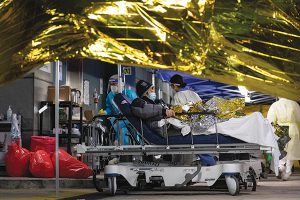Hong Kong feels like it’s on the edge of a nervous breakdown, and it’s tempting to ask how much more people can take. With reports circulating that authorities will impose some form of lockdown later this month, supermarket shelves are once again being stripped bare and long lines have formed outside pharmacies. More than two years after the start of the pandemic, the return of panic buying is a telling indicator of the government’s failure to win public trust. It raises questions over the longer-term mental health costs of a virus strategy that has placed adherence to mainland China’s Covid-zero policy ahead of all other considerations.
The symptoms of psychological distress extend beyond hoarding noodles and rice. Local media have featured stories of suicide attempts and protests at Penny’s Bay, the government’s bleak, Wi-Fi-free mandatory quarantine camp. In one video that was widely shared, a distraught woman screams and attacks a government worker in protective gear. The rest of the city is far from at ease. Streets and shopping malls have emptied, deterred by a combination of spiraling infections and fear of what comes next. Public gatherings are already limited to two people.
Human beings are social animals. Deprived of the contact we need with fellow members of our species, most people suffer mental deterioration. There’s a reason that solitary confinement is seen as the worst form of imprisonment. Inmates placed in such conditions for long enough typically start to display symptoms of distress ranging from anxiety and depression to anger, paranoia and even hallucinations. Covid-19 has amounted to a giant, uncontrolled global experiment in reducing social contact — and nowhere more so than in Hong Kong.
Now, with infections exploding to more than 50,000 a day and the financial hub reporting one of the world’s highest fatality rates, the government is considering a lockdown later this month.
—Bloomberg
 The Gulf Time Newspaper One of the finest business newspapers in the UAE brought to you by our professional writers and editors.
The Gulf Time Newspaper One of the finest business newspapers in the UAE brought to you by our professional writers and editors.
